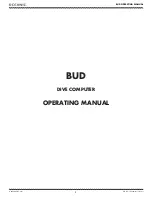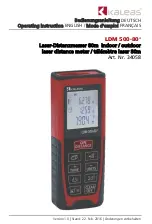
C
215
1-717-767-6511
4.0 R
EVIEWING THE
F
RONT
B
UTTONS AND
D
ISPLAY
5.0 S
CALING THE
M
ETER
RATE SCALING
To scale the Rate, enter a Scaling Display value with a corresponding Scaling
Input value. These values are internally plotted to a Display value of 0 and Input
value of 0 Hz. A linear relationship is formed between these points to yield a
rate display value that corresponds to the incoming input signal rate. The
location of the scaling point should be near the process end limit for the best
possible accuracy. The PAXLR is capable of showing a rate display value for
any linear process.
SCALING CALCULATION
If a display value versus input signal (in pulses per second) is known, then
those values can be entered into Scaling Display (
) and Scaling Input
(
). No further calculations are needed.
If only the number of pulses per ‘single’ unit (i.e. # of pulses per foot) is
known, then it can be entered as the Scaling Input value and the Scaling Display
value will be entered as the following:
NOTES
:
1. If # of pulses per unit is less than 10, then multiply both Input and Display
values by 10.
2. If # of pulses per unit is less than 1, then multiply both Input and Display
values by 100.
3. If the Display value is raised or lowered, then Input value must be raised
or lowered by the same proportion (i.e. Display value for per hour is
entered by a third less (1200) then Input value is a third less of # of pulses
per unit). The same is true if the Input value is raised or lowered, then
Display value must be raised or lowered by the same proportion.
4. Both values must be greater than 0.0.
EXAMPLE:
1. With 15.1 pulses per foot, show feet per minute in tenths.
Scaling Display = 60.0 Scaling Input = 15.1
2. With 0.25 pulses per gallon, show whole gallons per hour. (To have greater
accuracy, multiply both Input and Display values by 10.)
Scaling Display = 36000 Scaling Input = 2.5
RATE DISPLAY OVERFLOW
The rate of the input signal along with the programmed scaling values can
cause the calculated rate display to exceed the meter’s 6-digit capacity. If this
occurs, the display will show “
” to indicate an overflow condition.
INPUT FREQUENCY CALCULATION
The meter determines the input frequency by summing the number of falling
edges received during a sample period of time. The sample period begins on the
first falling edge. At this falling edge, the meter starts accumulating time
towards Low Update and High Update values. Also, the meter starts
accumulating the number of falling edges. When the time reaches the Low
Update Time value, the meter looks for one more falling edge to end the sample
period. If a falling edge occurs (before the High Update Time value is reached),
the Rate display will update to the new value and the next sample period will
start on the same edge. If the High Update Time value is reached (without
receiving a falling edge after reaching Low Update Time), then the sample
period will end but the Rate display will be forced to zero. The High Update
Time value must be greater than the Low Update Time value. Both values must
be greater than 0.0. The input frequency calculated during the sample period, is
then shown as a Rate value determined by either scaling method.
RATE PER
DISPLAY (
)
INPUT (
)
Second
1
# of pulses per unit
Minute
60
# of pulses per unit
Hour
3600
# of pulses per unit
KEY
DISPLAY MODE OPERATION
PROGRAMMING MODE OPERATION
PAR
Access Programming Mode
Store selected parameter and index to next parameter
S
No Function
Increment selected digit of parameter value
T
No Function
Select digit position in parameter value
Courtesy of Steven Engineering, Inc.-230 Ryan Way, South San Francisco, CA 94080-6370-Main Office: (650) 588-9200-Outside Local Area: (800) 258-9200-www.stevenengineering.com
























